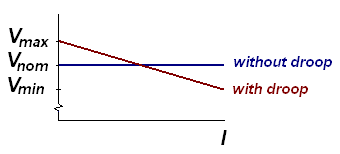Voltage droop
Voltage droop is the intentional loss in output voltage from a device as it drives a load. Adding droop in a voltage regulation circuit increases the headroom for load transients.
Although it may seem counterproductive, a series resistor is included between the regulator output and the load. The resistance needs to be chosen so that at maximum output current, the output voltage at the load is the minimum acceptable. Conversely, when the output current is (near) zero, the voltage is near the maximum. This follows simply from Ohm's law. The behaviour of the system with and without the added droop resistor is as follows:
In a regulator not employing droop, when the load is suddenly increased very rapidly (i.e. a transient), the output voltage will momentarily sag. Conversely, when a heavy load is suddenly disconnected, the voltage will show a peak. The output decoupling capacitors have to "absorb" these transients before the control loop has a chance to compensate. A diagram of such transients is shown below. The maximum allowed voltage swing in such a transient is .
Comparing this to a regulator with droop, we find that the maximum allowed swing has doubled: it is now . This increased tolerance to transients allows us to decrease the number of output capacitors, or get better regulation with the same number of capacitors.
See also
References
- Maxim-IC application note
- Speed Droop and Power Generation. Application Note 01302. Woodward Governor Company (2004).
- Intersil Application Note 1021 (June 2002)





